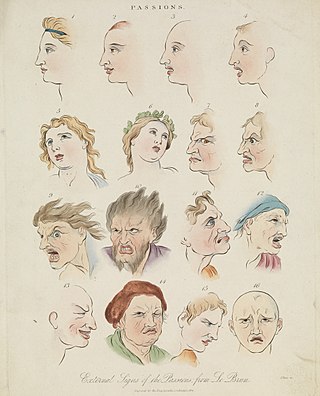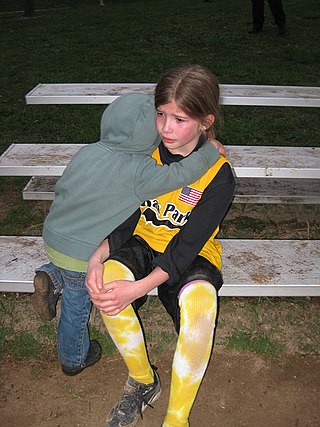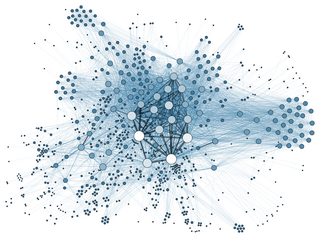
Emotions are mental states brought on by neurophysiological changes, variously associated with thoughts, feelings, behavioral responses, and a degree of pleasure or displeasure. There is currently no scientific consensus on a definition. Emotions are often intertwined with mood, temperament, personality, disposition, or creativity.
A meme is an idea, behavior, or style that spreads by means of imitation from person to person within a culture and often carries symbolic meaning representing a particular phenomenon or theme. A meme acts as a unit for carrying cultural ideas, symbols, or practices, that can be transmitted from one mind to another through writing, speech, gestures, rituals, or other imitable phenomena with a mimicked theme. Supporters of the concept regard memes as cultural analogues to genes in that they self-replicate, mutate, and respond to selective pressures. In popular language, a meme may refer to an Internet meme, typically an image, that is remixed, copied, and circulated in a shared cultural experience online.

Empathy is the capacity to understand or feel what another person is experiencing from within their frame of reference, that is, the capacity to place oneself in another's position. Definitions of empathy encompass a broad range of social, cognitive, and emotional processes primarily concerned with understanding others. Types of empathy include cognitive empathy, emotional empathy, somatic empathy, and spiritual empathy.

Gabriel Tarde was a French sociologist, criminologist and social psychologist who conceived sociology as based on small psychological interactions among individuals, the fundamental forces being imitation and innovation.
Sex differences in psychology are differences in the mental functions and behaviors of the sexes and are due to a complex interplay of biological, developmental, and cultural factors. Differences have been found in a variety of fields such as mental health, cognitive abilities, personality, emotion, sexuality, and tendency towards aggression. Such variation may be innate, learned, or both. Modern research attempts to distinguish between these causes and to analyze any ethical concerns raised. Since behavior is a result of interactions between nature and nurture, researchers are interested in investigating how biology and environment interact to produce such differences, although this is often not possible.
Emotional contagion is a form of social contagion that involves the spontaneous spread of emotions and related behaviors. Such emotional convergence can happen from one person to another, or in a larger group. Emotions can be shared across individuals in many ways, both implicitly or explicitly. For instance, conscious reasoning, analysis, and imagination have all been found to contribute to the phenomenon. The behaviour has been found in humans, other primates, dogs, and chickens.

Affect, in psychology, refers to the underlying experience of feeling, emotion or mood.
Cultural selection theory is the study of cultural change modelled on theories of evolutionary biology. Cultural selection theory has so far never been a separate discipline. However it has been proposed that human culture exhibits key Darwinian evolutionary properties, and "the structure of a science of cultural evolution should share fundamental features with the structure of the science of biological evolution". In addition to Darwin's work the term historically covers a diverse range of theories from both the sciences and the humanities including those of Lamark, politics and economics e.g. Bagehot, anthropology e.g. Edward B. Tylor, literature e.g. Ferdinand Brunetière, evolutionary ethics e.g. Leslie Stephen, sociology e.g. Albert Keller, anthropology e.g. Bronislaw Malinowski, Biosciences e.g. Alex Mesoudi, geography e.g. Richard Ormrod, sociobiology and biodiversity e.g. E.O. Wilson, computer programming e.g. Richard Brodie, and other fields e.g. Neoevolutionism, and Evolutionary archaeology.
The theory of constructed emotion is a theory in affective science proposed by Lisa Feldman Barrett to explain the experience and perception of emotion. The theory posits that instances of emotion are constructed predictively by the brain in the moment as needed. It draws from social construction, psychological construction, and neuroconstruction.
According to some theories, emotions are universal phenomena, albeit affected by culture. Emotions are "internal phenomena that can, but do not always, make themselves observable through expression and behavior". While some emotions are universal and are experienced in similar ways as a reaction to similar events across all cultures, other emotions show considerable cultural differences in their antecedent events, the way they are experienced, the reactions they provoke and the way they are perceived by the surrounding society. According to other theories, termed social constructionist, emotions are more deeply culturally influenced. The components of emotions are universal, but the patterns are social constructions. Some also theorize that culture is affected by emotions of the people.
Discrete emotion theory is the claim that there is a small number of core emotions. For example, Silvan Tomkins concluded that there are nine basic affects which correspond with what we come to know as emotions: interest, enjoyment, surprise, distress, fear, anger, shame, dissmell and disgust. More recently, Carroll Izard at the University of Delaware factor analytically delineated 12 discrete emotions labeled: Interest, Joy, Surprise, Sadness, Anger, Disgust, Contempt, Self-Hostility, Fear, Shame, Shyness, and Guilt.

The sociology of the Internet involves the application of sociological theory and method to the Internet as a source of information and communication. The overlapping field of digital sociology focuses on understanding the use of digital media as part of everyday life, and how these various technologies contribute to patterns of human behavior, social relationships, and concepts of the self. Sociologists are concerned with the social implications of the technology; new social networks, virtual communities and ways of interaction that have arisen, as well as issues related to cyber crime.
Jussi Parikka is a Finnish new media theorist and Professor in Digital Aesthetics and Culture at Aarhus University, Denmark. He is also (visiting) Professor in Technological Culture & Aesthetics at Winchester School of Art as well as Visiting Professor at FAMU at the Academy of Performing Arts in Prague. In Finland, he is Docent of digital culture theory at the University of Turku. Until May 2011 Parikka was the Director of the Cultures of the Digital Economy (CoDE) research institute at Anglia Ruskin University and the founding Co-Director of the Anglia Research Centre for Digital Culture. With Ryan Bishop, he also founded the Archaeologies of Media and Technology research unit.
Group affective tone represents the consistent or homogeneous affective reactions within a group.
Limbic resonance is the idea that the capacity for sharing deep emotional states arises from the limbic system of the brain. These states include the dopamine circuit-promoted feelings of empathic harmony, and the norepinephrine circuit-originated emotional states of fear, anxiety and anger.

Social contagion involves behaviour, emotions, or conditions spreading spontaneously through a group or network. The phenomenon has been discussed by social scientists since the late 19th century, although much work on the subject was based on unclear or even contradictory conceptions of what social contagion is, so exact definitions vary. Some scholars include the unplanned spread of ideas through a population as social contagion, though others prefer to class that as memetics. Generally social contagion is understood to be separate from the collective behaviour which results from a direct attempt to exert social influence.

Culture jamming is a form of protest used by many anti-consumerist social movements to disrupt or subvert media culture and its mainstream cultural institutions, including corporate advertising. It attempts to "expose the methods of domination" of mass society.
Viral phenomena or viral sensation are objects or patterns that are able to replicate themselves or convert other objects into copies of themselves when these objects are exposed to them. Analogous to the way in which viruses propagate, the term viral pertains to a video, image, or written content spreading to numerous online users within a short time period. This concept has become a common way to describe how thoughts, information, and trends move into and through a human population.
Media archaeology or media archeology is a field that attempts to understand new and emerging media through close examination of the past, and especially through critical scrutiny of dominant progressivist narratives of popular commercial media such as film and television. Media archaeologists often evince strong interest in so-called dead media, noting that new media often revive and recirculate material and techniques of communication that had been lost, neglected, or obscured. Some media archaeologists are also concerned with the relationship between media fantasies and technological development, especially the ways in which ideas about imaginary or speculative media affect the media that actually emerge.
Garnet Hertz is a Canadian artist, designer and academic. Hertz is Canada Research Chair in Design and Media Art and is known for his electronic artworks and for his research in the areas of critical making and DIY culture.







